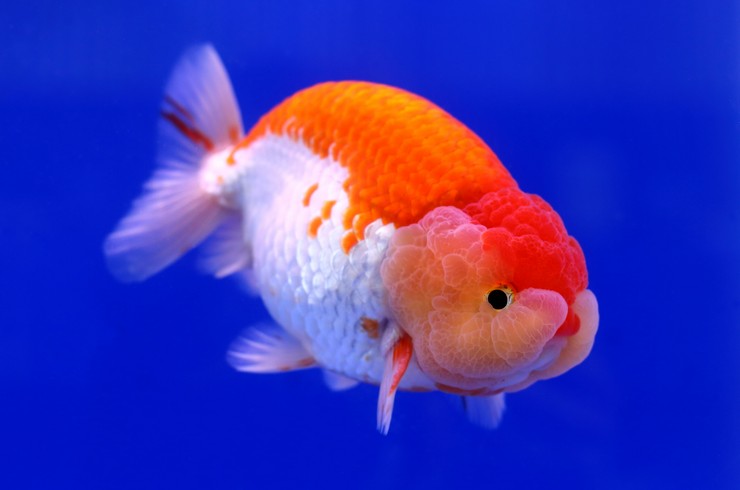The number of breeds of goldfish is simply amazing, at the moment there are more than 300 of them. This great diversity has been facilitated by hundreds of years of various crossings and careful selection. Some breeds were obtained due to the keeping of fish in terrible conditions: aquariums with large overcrowding, very warm water with rare changes, abundant feeding of natural high-protein feed. This led to outbreaks of infections, due to which the belly of goldfish swelled, creating the prerequisites for genetic changes, which were subsequently consolidated by selection.
Initially, 4 main breeds were created: Riukin, Wakin, Ranchu, and Deakin, from the various variations of which all the variety of modern variations was derived. All breeding goldfish are divided into two large groups: long-bodied (comet, wakin, etc.) and short-bodied (telescope, oranda, etc.). The first group is the closest to the original shape, the differences are usually in the shape and size of the fins. The breeds of the second group have undergone much more significant changes, affecting the entire body of the fish. Due to serious changes in all organs, the life span of such forms is greatly reduced.
An interesting direction in goldfish breeding is breeding breeds with eyes directed upwards. This is due to the historical traditions of fish placement. In Europe, they are used to watching goldfish from the side, and in Asian countries – from above.
Common Goldfish
This breed is closest to its natural form – the silver carp and actually differs from it only in color. The body is elongated, the color is bright, red-orange. Less common are red color options with black spots and chintz – red-black-white. The scales have a pronounced metallic luster. The tail fin of the goldfish is single, short. Abdominal and thoracic – paired. Requires room for swimming, so long aquariums are desirable. They grow up to 30 cm. Under good conditions, goldfish can live from 10 to 30 years.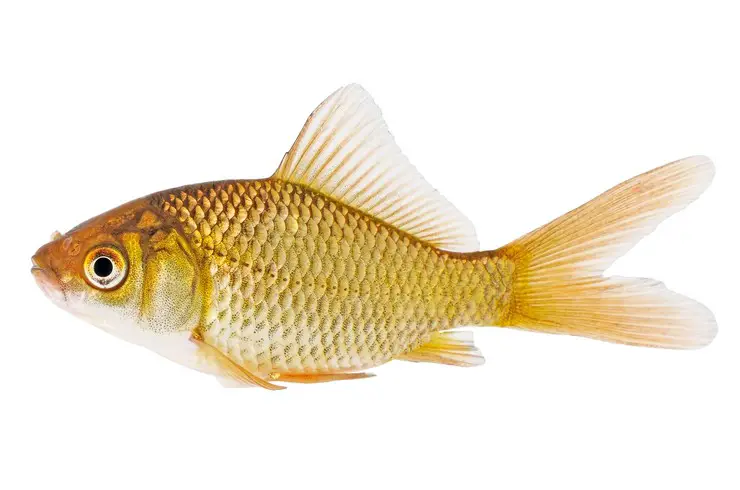
Telescope Goldfish
The telescope is one of the most popular and unusual goldfish breeds. The first copies were bred in China in the 18th century, after which Japan took over the baton. Telescopes have many unusual synonymous names. In the Land of the Rising Sun, the fish is usually called dem kin. In many Asian countries, you can find the name Dragon Fish or Dragon Eye. The names speak for themselves and emphasize the key feature of the fish – highly developed eyes that sit on special stalks and protrude some distance from the skull. Otherwise, it is a standard short-bodied goldfish with a forked tail fin. It should be noted that juveniles do not have characteristic bulging eyes; they begin to appear only by six months from the moment of birth. Some telescopes can have stems up to 2 cm long. Telescopes currently have several types of eyes:
- Eyes in the form of a dome, hemispherical, protruding partially (Dome Eyes).
- Flat eyes are cylindrical with a flat surface (Flat Eyes).
- The eyes are completely protruding and resemble a sphere (Globe Eyes).
There are a large number of color forms and variations. Individuals with completely black color are especially appreciated. In the United States, they are commonly called Black Moor Goldfish. Our compatriots have noted in creating one of the most beautiful forms of the telescope: at the end of the 19th century, a stable version of the telescope with black color and a long tail was obtained. It was named the Moscow Black Telescope. He was popular both in our country and abroad. In 1941, an amateur aquarist Andrianov obtained a black telescope with bright red eyes.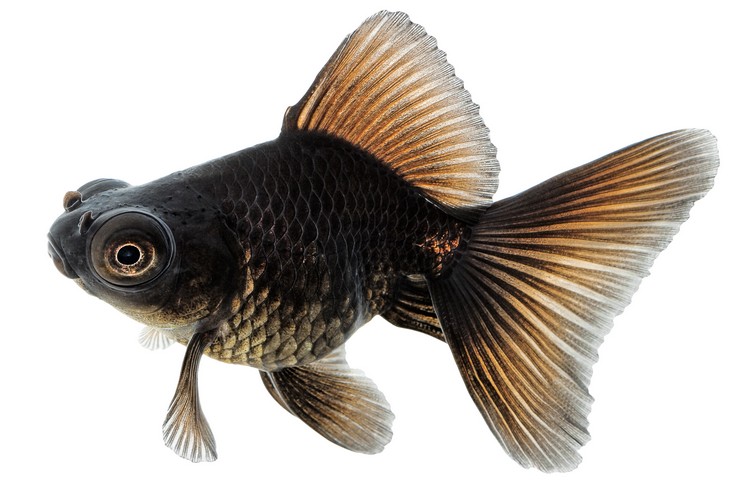
Goldfish Butterfly tail
The rock went on sale about 40 years ago and is a type of telescope. A distinctive feature is the double tail fin, which resembles the wings of a butterfly when viewed from above. The eyes of the fish are bulging. The color can be varied: for example, black and white (“Panda”), red and black specks (“Red panda”), etc. When keeping in an aquarium, do not install decorations with sharp edges – eyes and tail may be damaged. The size is about 10 cm. Life expectancy is 10-15 years.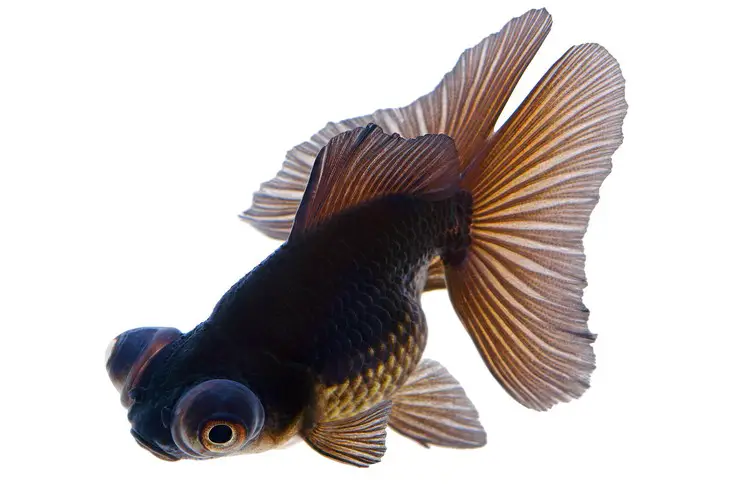
Wakin (Goldfish Wakin)
Large goldfish for large aquariums and decorative ponds grows up to 20 cm or more. This breed can be considered the progenitor of many forms of goldfish. Divorced in Japan since the beginning of the 17th century. The body is torpedo-shaped, the tail is forked. It differs from koi carp in the absence of antennae. In addition to the caudal fin, a feature is an unusual coloration – large red-orange or yellow spots on a white background. The bright red color is considered the most valuable. They can live in an aquarium for up to 20 years.
Water eyes (Goldfish Bubble Eye)
One of the most unusual breeds of goldfish. The body is ovoid, the tail is bifurcated. A special feature is the presence of two bubbles under the eyes, hanging on the sides, filled with liquid. They can reach up to ¼ body size. The color is varied, you can find: red-orange, chintz, black, pink, etc. They are formed in young goldfish at an age closer to two years. The eyes are directed upward, the dorsal fin is absent. When keeping in an aquarium, remember that bags of liquid can burst. They will recover later but may vary in size. In addition, an infection can get into the wound, so for goldfish, it is recommended to install decorations without sharp edges. Water eyes are very delicate goldfish and are susceptible to bacterial and fungal diseases. The maximum size is up to 13 cm, the life expectancy is up to 15 years.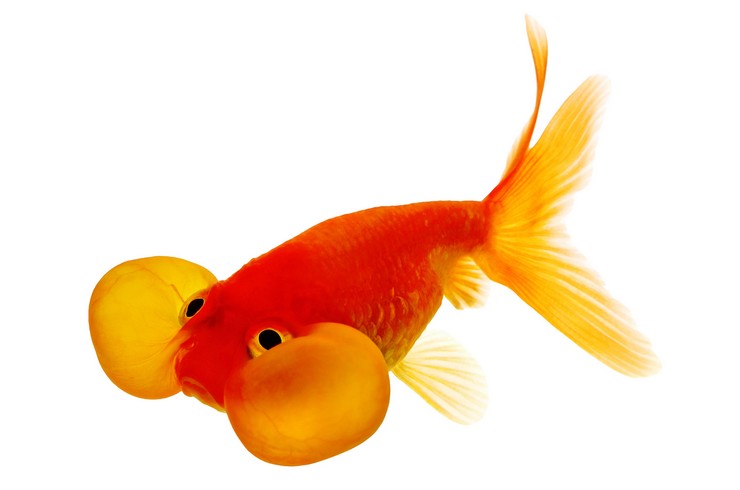
Veiltail Goldfish
One of the most beautiful breed forms, but a rather capricious goldfish, which has specific characteristics for keeping. A distinctive feature of this breed is its fins. They are long and thin, reach large sizes, and look like a veil. The body is shortened, the abdomen is rounded. The dorsal fin of the goldfish is well developed, can reach a size of 6 cm. The caudal and anal fin are bifurcated. There are various colors: white, red-orange, chintz, etc. It has a tendency to certain diseases. Very often, golden veil-tails have swim bladder problems. This is explained by the fact that the selection followed the path of a selection of individuals with a shortened body. Consequently, all internal organs also changed and became denser. A reduced swim bladder can sometimes fail to function properly. The plush tail fin of the veiltail goldfish is their pride and their burden: prone to numerous injuries, it can serve as a breeding ground for bacterial and fungal infections. In an aquarium, they grow up to 18 cm and live, on average, 10-15 years.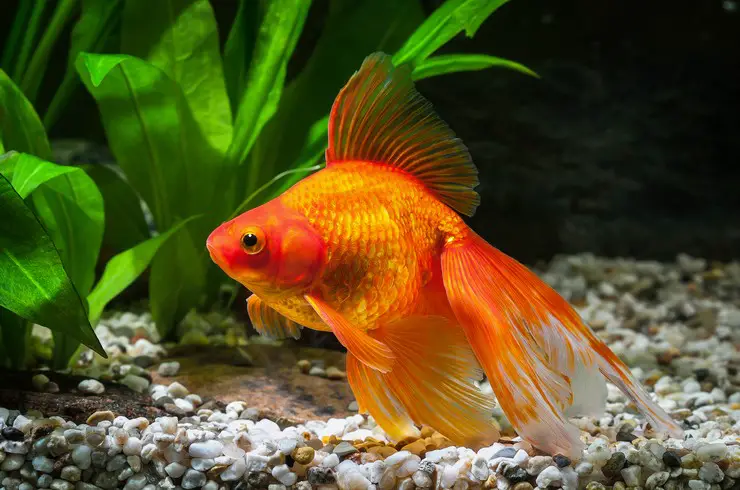
Pearl (Goldfish Pearlscale)
This relatively young breed of goldfish (bred in the early 19th century) has an almost perfect spherical body. The head is small and narrow. The scales on the body have a dark outline and stand out in contrast, from the side they look like droplets. The classic color option for a goldfish pearl is red-orange, but on sale, you can find a wide range of colors: blue, black, white with various colored splashes. There are breeds with caps similar to oranda. In the aquarium, the size of the fish does not exceed 10 cm. It is considered a fairly hardy breed, but when keeping it, it is necessary to take into account the slowness and clumsiness: the goldfish may not get food.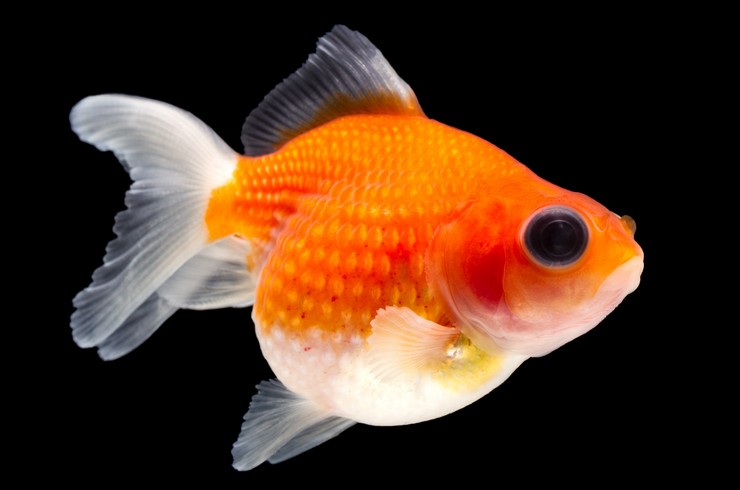
Celestial Eye Goldfish
Another popular name for this goldfish is the Heavenly Eye. The breed features the complete absence of a dorsal fin and the presence of protruding eyes, similar to the eyes of a telescope, with only one difference – the stargazer’s eyes are directed upwards. It was first obtained in China at the beginning of the 19th century, a century later it was brought to Japan, where local breeders brought the goldfish breed to modern standards. It has a short, egg-shaped body. The anal and caudal fins are bifurcated. There are several color variations: black, orange, gray, etc. The special structure of the organs of vision imposes a number of restrictions on maintenance: in the aquarium, you cannot use decorations with sharp edges and select active fish that can damage the eyes in the neighbors. An interesting fact: at a young age, the eyes of the fish are located normally, but they change as they grow. The size of the fish in the aquarium does not exceed 13 cm.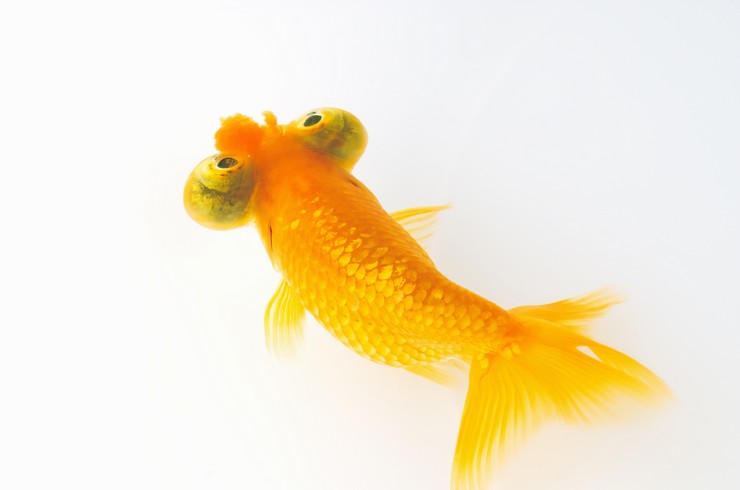
Comet (Goldfish Comet)
The breed has a torpedo-like body, elongated fins, and a long single tail with deep bifurcation. It is a further development of the classic goldfish. It was bred in the USA and is one of the hardiest forms. For a comet, it is necessary to provide a suitable aquarium of 40 liters or more, preferably an elongated one: the goldfish likes to swim very actively. They tend to jump out, so cover the aquarium with a lid. The classic color combination is red and white, but you can find forms silvery, pearlescent, white, etc. The average size when kept – 10 cm, life expectancy – up to 14-15 years.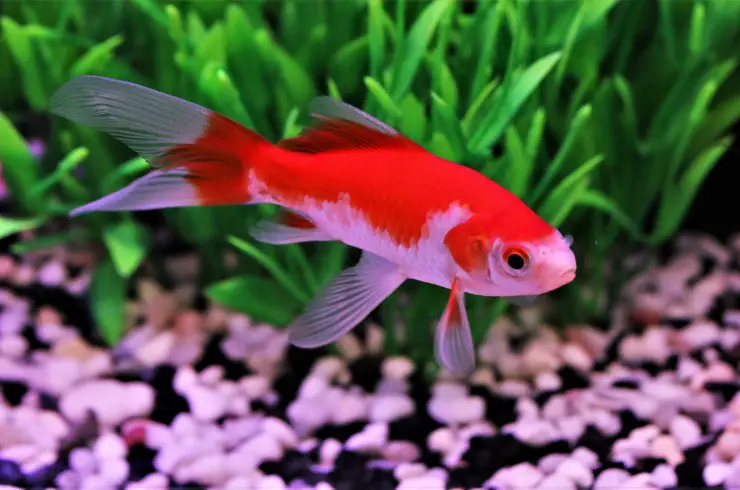
Nanking
This breed of goldfish was created by Japanese breeders in the middle of the 18th century. The name of the fish is most likely associated with the large Chinese port city of Nanjing, once the former capital of the state. The original producers for the creation of this breed were also exported to Japan from this city. And since at that time it was common practice to call any product that entered the country by the name of the city where the cargo came from, the name Nanjing was also stuck for goldfish. Nowadays, it is very difficult to acquire this fish outside of Japan, since the government of the country classified the breed as a specially protected breed, which led to a sharp decline in exports. Nanjing has an ovoid body, a forked short tail. The dorsal fin is absent. The average body size is 13 cm. The classic color is copper-red, with red fins and head. On the basis of traditional Nanjing, two variations with unusual names were developed: “White duck egg” (the body is completely white, the fins are pinkish, the gill covers and the bases of the fins are bright red) and “Black Dragon Egg” (velvet black color, bulging eyes and warty ” hat “on the head).
Oranda Goldfish
A characteristic feature of the oranda goldfish is a leathery growth (resembling a cap), which differs in color from the main body color. It is laid at 3-4 months of the fish’s life and finishes its formation in two years. Also, growths are allowed on the operculum. The body shape of goldfish may differ: the Japanese prefer more elongated individuals, while in China, short-bodied varieties are popular. The abdomen is rounded, the fins of the goldfish are clearly bifurcated and often very long. The color has a wide range of variations: red, black, blue, and their various combinations. The “little red riding hood” variation stands apart – its body is absolutely white, the bump on its head is bright red. In the East, oranda goldfish are very much appreciated, they are called nothing else than “Water Flowers”. There are interesting hybrids, for example, Oranda The dragon’s eye has an oranda body and eyes like a telescope. Goldfish are quite sensitive to water quality, therefore, when caring for them, you need to regularly monitor their parameters. The bumpy surface of the “cap” is sensitive to dirt – dirt, getting between the folds, can cause infection of the fish. Properly organized filtration is the key to success when keeping goldfish.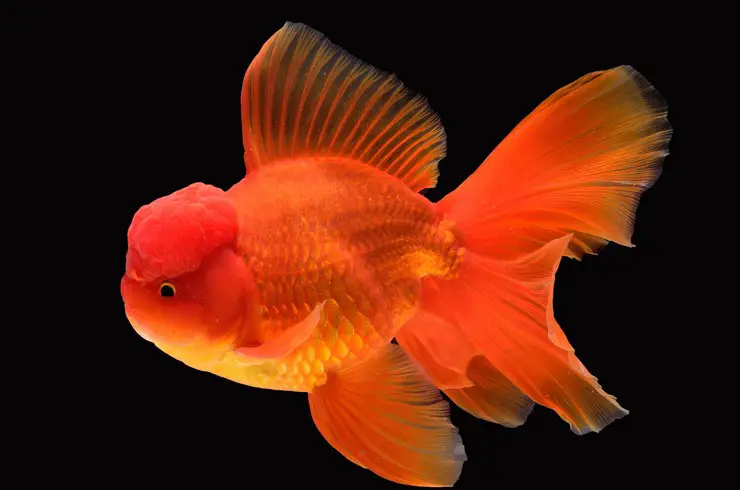
Oranda Red Riding Hood (Redcap Oranda Goldfish)
The most recognizable variation of the Oranda goldfish. The body is shortened, the abdomen is rounded, the fins are large, bifurcated. Body-color is white. On the top of the head, there is a warty outgrowth of bright red color. The growth is laid at 3-4 months of life and reaches its maximum size at the age of 2 years. The oranda goldfish is sensitive to water quality and temperature. In the aquarium, they reach 15-20 cm in size.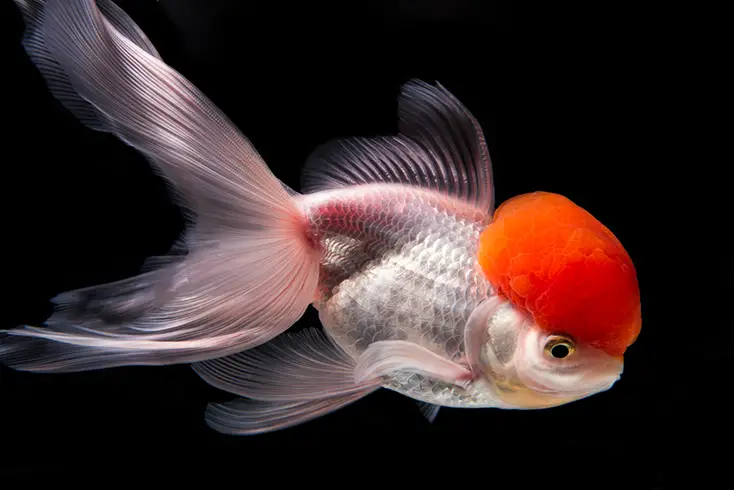
Pompon (Giroshima)
The pompom is not currently viewed as a separate breed, but rather as a trait that may appear in some breeds of goldfish. In this regard, in 1987 it was decided to divide fish with a similar feature into two main groups: Japanese pom-poms (this includes species with a dorsal fin) and Chinese pom-poms (breeds without a dorsal fin). The group of goldfish got their name for an interesting feature: their nasal valves are greatly enlarged (normally invisible) and form fluffy growths of various shapes and sizes on both sides of the mouth, but very reminiscent of pompons. They can be red, white, brown and blue. The most valuable are individuals in which the color of the pompons differs from the main body color. Unfortunately, the fish are not as popular as other breeds, but in the aquariums of goldfish connoisseurs, you can also find it.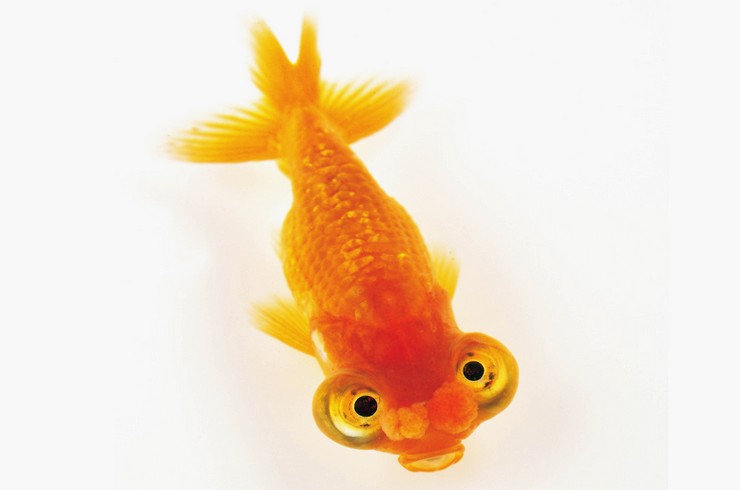
Ranchu Goldfish
This breed is one of the most popular in Japan and China. The ranch has a massive, short, rounded body. The back is wide, strongly curved towards the tail. In general, this breed of goldfish is very similar to the lion’s head, however, the latter has a more developed tail fin and a smoother back. The tail is small, sometimes divided into several parts. The classic and most popular goldfish color is a white speckled body and redhead growths. The breed was bred in the Land of the Rising Sun at the end of the 19th century and at first, did not have head tubercles, resembling raspberry in structure. Subsequent crosses and selection have led to the fact that the presence of outgrowths is now assigned to the breed standard. This makes the ranch and lion head breeds very close, sometimes it is very difficult to establish which particular breed certain fish belong to. A species aquarium is best suited for keeping. The unusual body shape does not allow goldfish to actively swim in the water column, therefore active related breeds are not suitable for joint keeping. The ranch goldfish do not like lower temperatures, so keeping in decorative ponds is not recommended.